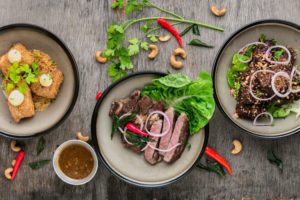 *Please be aware that the items on the list below are some general paleo template ideas. All recipes can be modified to remove restricted foods on the autoimmune and low fodmap templates.
*Please be aware that the items on the list below are some general paleo template ideas. All recipes can be modified to remove restricted foods on the autoimmune and low fodmap templates.
The Paleo Diet can be a fairly easy life-style change with some proper planning ahead of time. Paleo is broken down into five simple categories: fats, proteins, vegetables, nuts, and fruits. Be sure to stay away from grains or legumes. Grains and legumes are nutrient dense and can be inflammatory to the gut. With some simple meal and snack planning ideas as well as some tips for eating out, you will be well on your way in no time to feeling your best! Here are some meal planning ideas to help you get started and some simple thoughts to keep in mind.
Paleo Food List
MEAL IDEAS:
BREAKFAST
Eggs: Scrambled, over-easy, sunny-side-up, or poached with sautéed vegetables.
Protein shakes: Pea, beef, collagen, or whey protein mixed with unsweetened coconut milk and berries.
Not just “breakfast” foods: Don’t limit yourself to only “breakfast foods.” Fish, steak, vegetables, and leftover meals from the day before can be consumed for breakfast as well.
LUNCH
Salads: Chicken, tuna, egg, turkey, lamb, beef, and sausages can be added for protein.
Sautéed meat and veggies: Chicken, turkey, fish, lamb, or beef with sautéed vegetables or salad.
Dinner leftovers: Chicken, turkey, fish, or other meats with vegetables or salad.
Salmon filets: Can add asparagus or other side veggies.
Mushroom caps: These can be stuffed with ground turkey or pork and served with veggies.
Shepherd’s pie: Ground beef on the bottom layer and cauliflower and mixed veggies on top.
DINNER
Crockpot meals: Any kind of meat and appropriate veggies or starch. These are easy meals that can be made overnight and can last days at a time.
Rotisserie chickens: These can be purchased at Whole Foods or local grocery stores. Serve with veggies and safe starch when appropriate.
Bun-less burger: Can be served over a bed of fresh spinach, lettuce, or other veggies.
Sauerkraut and kielbasa: This is an easy meal and mustard can be served as a condiment.
Meatballs without breadcrumbs: Prepare with sea salt, pepper, crushed tomatoes, bay leaf, and garlic.
Spaghetti squash casserole: Meats and other veggies can be mixed in, along with herbs and seasoning.
EATING OUT
Baked chicken or fish: Request no sauces and no flour on them.
Ask for substitutions: Vegetables and salads in place of starches like french fries or baked potatoes.
Steak and veggies: Make sure there are no gluten seasonings added.
Salads: Add meats and vegetables.
Omelette: With sliced vegetables and a side of bacon.
The Bun-less Burger: Available at In & Out Burger or Five Guys. Ask for “protein style” gluten free.
Chipotle Bowl: Ask for a bowl with no grains. Add only meat, vegetables, and guacamole.
**Make it easy on yourself! Ask them to hold the basket of bread so it does not tempt you.
** Ask if your menu choice has any hidden flours. It is easier to tell your server that you have a gluten allergy so they take your food preferences more seriously. You may not have an immediate gluten allergenic reaction, but the delayed sensitivity allergenic reaction can be just as severe. Many people in the restaurant industry are not educated about this.
SNACKS
1 handful of nuts or seeds: 1-2 tablespoons of nut or seed butter can be great too. If on AIP, you will have to wait.
Hard-boiled eggs: are easy to carry with you on the go. If on AIP, you will have to wait.
1-2 oz. piece of meat: Chicken, Fish, Turkey, Beef, Lamb along with ½ c. vegetables.
Lettuce wrap: A piece of protein wrapped in a lettuce leaf, add in mustard and your choice of vegetable (bell pepper, tomato, cucumber, etc.).
High-quality protein shake: High-quality beef, collagen, pea protein with unsweetened coconut or almond milk, and berries.
Guacamole: Can be used as dip for other veggies like carrots and broccoli.
Healthy olives
*Make sure to stay away from your personal food sensitivities. Some will not apply if you are on AIP
Other Thoughts to Consider
Hidden Gluten: Read food labels carefully. Gluten can be hidden under such names as hydrolyzed vegetable protein, modified food starch, dextrin, and “natural flavorings”. Gluten might also be found in the alcohol used in flavorings such as vanilla, distilled vinegar and veined cheese such as Blue Cheese and Roquefort. Even the smallest amount could be enough to keep you from feeling the best that you can, so you will want to take extra care in finding those places that it might be hidden.
Balancing your Blood Sugar – Rules to Live By:
- Eat a balanced meal that includes protein within one hour of getting up.
- Always carry a snack with you in your car, briefcase, at a desk, or in a purse.
- Balance Protein, Fat, and Carbohydrate with each meal. Safe starch may be appropriate for some.
- If you are still hungry, have more protein, fat, and carbohydrate in the same ratios as opposed to having more of just one food group.
- Eat meals in a relaxed environment. Take time to sit down and be present with yourself to enhance the digestive process. We do not digest well when stressed.
- Create “Time released meals.” Approach your meals eating the protein & fats first, followed by your low carbohydrate content above ground non-starchy vegetables. Eating in this way enhances blood sugar management by reducing blood sugar spiking. Starch veggies can be added later if your blood sugar and weight is under control.
- Stock your kitchen well and keep it stocked with only healthful choices. Bad foods in your pantry and fridge will eventually be consumed.
Helpful Hints for the Holidays & Parties:
- Eat before you go to the party. Don’t go on an empty stomach, especially if it is cocktails, appetizers, or desserts that are being offered.
- Eat something first before the cocktail. Alcohol is absorbed directly from the stomach and will go directly into the bloodstream spiking your blood sugar.
- Chew your food slowly. Doing so will increase the body’s acknowledgment of the foods coming in and more quickly signal the brain of the contents of your consumption.
- Drink a water (mineral or plain) in between each cocktail. This reduces blood sugar load and the chance of blood sugar spiking. Also, alcohol dehydrates your body and the water and minerals will act to replace that which is lost.
- Make your contribution to a potluck or holiday. Bring some healthy choices for yourself and you may start a trend!
The Paleo Diet Modified for Gut Healing
The Paleo diet is a “gut friendly” diet. Many medical conditions stem from an unhealthy gut. As stated, Paleo is broken down into five simple categories: fats, proteins, vegetables, nuts, and fruits. However, when inflammation and gut issues are present affecting our over-all health, there are some temporary modifications that need to be made in order to heal the gut and begin the journey to recovery.
Here are 5 simple modification rules to keep in mind while implementing the Paleo diet for gut healing and health.
- If you suffer from gut issues or inflammation of the gut, start out by eating foods that are easily absorbed by the gut. For example, stay away from nuts for a time. They can be a burden to digest at first. Instead, eat nut butters that are already broken down so that it can be easily digested and absorbed more efficiently
- To help with optimum digestion and absorption, begin by cooking your meats and vegetables thoroughly. Raw vegetables can be difficult to digest by an unhealthy gut and can be abrasive. Sauté, steam, or roast the vegetables to softness for easy digestion and absorption. The end goal is to heal the gut so that you have the ability to digest raw vegetables and absorb the nutrients properly.
- If you have fluctuations in blood sugar (many times caused from stress), stay away from fruits that are high in sugar content. Berries are full of polyphenols that are great for the microbiome to promote gut healing. They are also low on the glycemic index which will help to stabilize blood sugar fluctuations.
- Use an Instant Pot or pressure cooker. Pressure breaks down Lectins which can be very damaging to the gut. Some very healthy foods contain lectin, such as sweet potatoes and other vegetables. Any foods containing lectin should be cooked under pressure to avoid further damage to the gut.
- Bonus: Bone broth is very healing to the gut. De-bone your meats and add the bones with onions and other flavorings to a pressure cooker. Cook on high pressure for 3 hours and enjoy home-made bone broth. Drink 4-6 ounces twice a day for gut healing.
Here is a quick YouTube video on food choices for gut healing.

